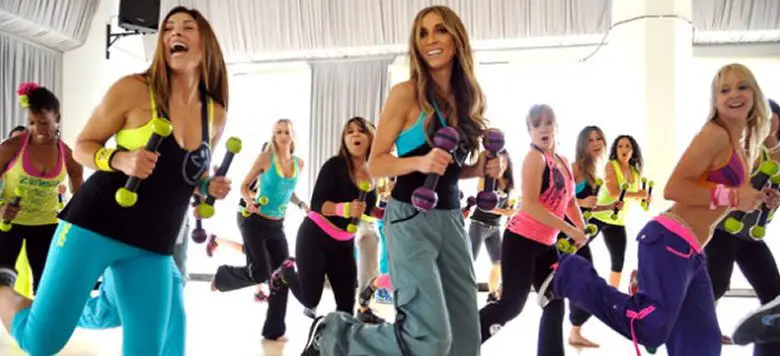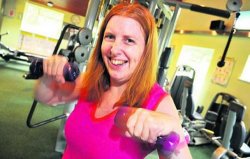
Get fit for 2015: Q&A with disabled Zumba instructor
Christmas is well and truly over [whimper of sadness] but now that means it’s time for a fresh start. So, we decided to talk to Sam James, a Zumba instructor with cerebral palsy, about getting fit in 2015.
Please can you tell Disability Horizons readers a bit about yourself?


But I have been bought up to be as independent as possible. I went to mainstream school and then to university.
After uni I was pressured into doing office work, which is what a lot of people believed was all I could do, but it was not me at all. Even so, I survived 9 years working in this environment. But having always been sporty, I knew I needed to do something different.
What first interested you in teaching Zumba fitness?
I got into Zumba as I love dance, but I never really had the chance to do attend dance schools in my area because of my disability. I’d heard about Zumba from a TV programme and wanted to try it straight away so my mum and I went and tried a class.
I loved it (mum didn’t!) and found that all the moves were adaptable for me, or anyone. With Zumba, it doesn’t matter what you look like or what moves you do, as long as you have a smile on your face, that’s all that matters.
Once I started going to my friend Sarah’s classes, she realised my potential and said I should do it myself and teach disabled people. At the time I wanted to, but personal circumstances did not allow it. After a difficult break up with my ex, and following on from an arm/shoulder injury, I explored the option.
Finding out what I would need to teach disabled people, I discovered Instructability – a joint venture between Aspire and YMCAFit to train Disabled people to become level 2 gym instructors, as well as level 3 Exercise and Disability Instructors. I applied, got on and passed both with flying colours. After a 3 month work placement in the gym I go to, I went on to do the Zumba Instructor training, which for me was a dream come true.
What challenges do you face being a disabled Zumba instructor?
It’s difficult keeping the routines fresh and dynamic with the moves I can do and making each song different.
I have also faced some negativity from some other instructors in my area, and some leisure centres as well, as some people cannot get there head around a disabled group exercise instructor. This only makes me more determined to succeed and to prove them wrong.
What reactions have you had from your clients?
All very positive, they like that I do proper Zumba and that I offer low and high impact options. They say I’m fun and mad and that they can have a good laugh with me as I don’t care if they go wrong! One of my regulars has never missed a class and has lost so much weight too, which makes me feel that I have achieved something with my own job.
Most of my regulars are now friends and I have been invited out for meals, BBQs etc, which has been the best bit for me.
How do you adapt the dance moves to work around various disabilities?
I adapt to the person involved. I always show low and high impact options and I work with the disabled person to their strengths. I am always adapting on the spot in every class I do as I attract all types of people and some do struggle so its about thinking on your feet quickly and showing a option that they can do. Because of my own disability I cannot put in complicated moves as I cannot do them, and I only have slow turns as I get dizzy doing fast ones!
I’m working with the local Downs Syndrome Association in providing Zumba classes, and with them it’s all about visual cues over verbal, so it’s coming up with fun visual cues that they can pick up and remember with a very basic routine that they can follow alongside fun funky Zumba music.
Is Zumba as effective for a disabled person as it is for a non-disabled person?
Yes, if not even more so. With Zumba you are using all aspects of your body and you use every type of muscle group.
It’s also really fun and gets your brain working. It involves the great Latin dance steps from dances such as Salsa, Flemanco, Tango, Bollywood and Samba, to name just a few. So you are learning basic dance steps and socialising as well. I have made so many new friends via Zumba classes. One of my closest friends starting off standing next to me four years ago in a Zumba class and now we are very close. To me the social aspect is paramount – it gives you a new lease of life.
I have read on your website that you teach Boxexercise in addition to Zumba, can you tell us what that involves?
Yes Boxercise is boxing moves involving a circuit-style keep fit class as well as pads and gloves. I use different drills to keep the impact high for the best results. This is also really good for wheelchair users as they can do the glove/pad work and work the core muscles. It’s even better if they can transfer onto the floor and do the pad work that way.
What are your top 5 fitness tips?
- Don’t be afraid to go out and exercise – any good instructor will be able to adapt moves for you. Don’t be afraid of trying a few instructors to see who suits you the best.
- Find something you enjoy and go to it. For me it was Zumba, but it could be the gym, boxing, weightlifting, step, swimming, Boccia etc.
- Have a balanced diet – this is as equally important as exercising.
- Have a routine and keep at it, for example, go straight from work once and week and always take a friend or family member.
- Don’t give up, give it a few weeks and ENJOY!!
If anyone is interested in joining one of your classes, how can sign up?
They just have to go to my website – www.samjames.zumba.com – see my classes and contact the centre I teach at.
I am also available for groups and associations/charities to hire to put on private classes for members or for events. I can host a Zumbathon, which is about 3 – 4 hours of Zumba with 3 – 4 different instructors doing different sets to raise money for that particular cause.
As well as my website, I’m on Twitter.
Where do you deliver your classes and how long do they last?
I currently teach Zumba at a local council leisure site and I teach Aqua Zumba for a local hotel gym. I also do private classes for the Downs Syndrome Association in Swindon and private Boxercise class for a local Physical Impaired Unit at a local Mainstream School.
Classes are either 45 minutess or a hour long, depending on where and the group. All Aqua Zumba classes are 45 minutes long.
What qualifications do you need to become a Zumba instructor?
You don’t need any qualifications. Personally I do recommend having a Level 2 Gym Instructor or ETM (exercise to music) qualification, as then you are more prepared and have more knowledge on how the body works. It also means that if someone in your class injures themselves, you are better prepared.
What advice would you give disabled people who may wish to peruse a career as a Zumba fitness instructor?
Go for it! There is lots of training materials on Zumba.com, which promotes disabled instructors and many have been on stage with Beto, the creator of Zumba (I’m still waiting for my chance to be on stage with him!).
I would say go to a few classes beforehand with a range of instructors as each one will be different, so you can gain ideas and see what you like. Zumba instructors are very lucky as we have a lot of control over the content and song choices in our classes.
Also consider Instructability as this is free training for unemployed disabled people aged 16 and over.
By Zubee
Check out…
• Q&A with Ashley Thomson: one-handed hairdresser
• Top 10 disability-related YouTube videos
• Access All Areas: accessible activities in the New Forest
Get in touch by messaging us on Facebook, tweeting us @DHorizons, emailing us at editor@disabilityhorizons.com or leaving your comments below.